Optimization Study on the Comfort of Human-Seat Coupling System in the Cab of Construction Machinery
Abstract
:1. Introduction
- (1)
- Most previous studies on the comfort of human-seat systems had used experimental methods, which were costly and less reproducible. At the same time, the finite element method currently used by a few scholars is too simple to equate to the dummy model, and the equivalence of human bones and organs is incomplete. Since the contact pressure between the dummy and the seat is mainly reflected by the seat body pressure distribution [30,31], therefore, the sponge material properties and the accuracy of the seat finite element model have a significant influence on the simulation result, and the existing seat model is inaccurate in defining the sponge material by equivalent stiffness.
- (2)
- More critical is that the previous research on human-seat system comfort only focused on one of the performance improvements of body pressure comfort or vibration comfort without considering both simultaneously. Especially for construction machinery in the work process, the operator faces strong vibration from the frame. Therefore, in optimizing seat performance, it is necessary to improve the seat vibration isolation performance while meeting the body pressure comfort so that the operator can obtain more excellent seat comfort performance.
2. Human-Seat Coupling Finite Element Model
2.1. Dummy Model Introduction
2.2. Seat Model Introduction
2.3. Human-Seat Coupling Finite Element Model
3. Human-Seat Coupling Model Comfort Test and Validation
3.1. Test Scheme
3.2. Evaluation Index
3.2.1. Body Pressure Distribution Test Verification Indexes
3.2.2. Vibration Response Test Verification Indexes
3.3. Test Verification
4. Seat Comfort Optimization Research
4.1. Optimized Scheme
4.2. Optimization Validation
4.2.1. Optimized Verification of the Body Pressure Distribution Comfort
4.2.2. Vibration Comfort Optimization Verification
5. Conclusions
Author Contributions
Funding
Data Availability Statement
Conflicts of Interest
References
- Kolich, M.; Taboun, S. Ergonomics modelling and evaluation of automobile seat comfort. Ergonomics 2004, 47, 841–863. [Google Scholar] [CrossRef] [PubMed]
- Manentca, I.; Corlett, A. A Model of Vehicle Comfort and a Method for Its Assessment. Ergonomics 1973, 16, 849–854. [Google Scholar] [CrossRef]
- Huang, H.B.; Wu, J.H.; Huang, X.R.; Yang, M.L.; Ding, W.P. A generalized inverse cascade method to identify and optimize vehicle interior noise sources. J. Sound Vib. 2020, 467, 115062. [Google Scholar] [CrossRef]
- McMahon, K.J. Whole-Body Vibration Comfort Measurement aboard the S. A. Agulhas II and just Noticeable Difference Threshold Testing in the Laboratory. Master’s Thesis, Stellenbosch University, Stellenbosch, South Africa, 2014. [Google Scholar]
- Park, S.; Kim, C. The Evaluation of Seating Comfort by the Objective Measures; SAE International: Warrendale, PA, USA, 1997. [Google Scholar] [CrossRef]
- Huang, H.; Huang, X.; Ding, W.; Zhang, S.; Pang, J. Optimization of electric vehicle sound package based on LSTM with an adaptive learning rate forest and multiple-level multiple-object method. Mech. Syst. Signal Process. 2023, 187, 109932. [Google Scholar] [CrossRef]
- Inagaki, H.; Taguchi, T.; Yasuda, E.; Iizuka, Y. Evaluation of riding comfort: From the viewpoint of interaction of human body and seat for static, dynamic, long time driving. SAE Trans. 2000, 109, 960–964. [Google Scholar] [CrossRef]
- Hartung, J.; Mergl, C.; Bubb, H. Reliability of Pressure Measurement on Car Seats. SAE Trans. 2004, 113, 874–880. [Google Scholar] [CrossRef]
- Huang, H.; Huang, X.; Ding, W.; Yang, M.; Yu, X.; Pang, J. Vehicle vibro-acoustical comfort optimization using a multi-objective interval analysis method. Expert Syst. Appl. 2023, 213, 119001. [Google Scholar] [CrossRef]
- Milivojevich, A.; Stanciu, R.; Russ, A.; Blair, G.R.; Heumen, J.D. Investigating Psychometric and Body Pressure Distribution Responses to Automotive Seating Comfort; SAE International: Warrendale, PA, USA, 2000. [Google Scholar] [CrossRef]
- Gruevski, K.M.; Holmes, M.W.; Gooyers, C.E.; Dickerson, C.R.; Callaghan, J.P. Lumbar postures, seat interface pressures and discomfort responses to a novel thoracic support for police officers during prolonged simulated driving exposures. Appl. Ergon. 2016, 52, 160–168. [Google Scholar] [CrossRef]
- Park, S.; Min, S.N.; Subramaniyam, M.; Lee, D.; Lee, H.; Kim, D.G. Analysis of Body Pressure Ratio for Evaluation of Automotive Seating Comfort; SAE International: Warrendale, PA, USA, 2014. [Google Scholar] [CrossRef]
- Mergl, C.; Klendauer, M.; Mangen, C.; Bubb, H. Predicting Long Term Riding Comfort in Cars by Contact Forces between Human and Seat; SAE International: Warrendale, PA, USA, 2005. [Google Scholar] [CrossRef]
- Ebe, K.; Griffin, M.J. Factors affecting static seat cushion comfort. Ergonomics 2001, 44, 901–921. [Google Scholar] [CrossRef]
- Basri, B.; Griffin, M.J. The application of SEAT values for predicting how compliant seats with backrests influence vibration discomfort. Appl. Ergon. 2014, 45, 1461–1474. [Google Scholar] [CrossRef] [Green Version]
- Nawayseh, N. Effect of the seating condition on the transmission of vibration through the seat pan and backrest. Int. J. Ind. Ergon. 2015, 45, 82–90. [Google Scholar] [CrossRef]
- Huang, H.; Huang, X.; Ding, W.; Yang, M.; Fan, D.; Pang, J. Uncertainty optimization of pure electric vehicle interior tire/road noise comfort based on data-driven. Mech. Syst. Signal Process. 2022, 165, 108300. [Google Scholar] [CrossRef]
- Bhiwapurkar, M.K.; Saran, V.H.; Harsha, S.P. Seat to Head Transmissibility during Exposure to Vertical Seat Vibration: Effects of Posture and Vibration Magnitude. Int. J. Acoust. Vib. 2019, 24, 3–11. [Google Scholar] [CrossRef]
- Fairley, T.E.; Griffin, M.J. A Test Method for the Prediction of Seat Transmissibility; SAE International: Warrendale, PA, USA, 1986. [Google Scholar] [CrossRef]
- Fairley, T.E.; Griffin, M.J. The apparent mass of the seated human body: Vertical vibration. J. Biomech. 1989, 22, 81–94. [Google Scholar] [CrossRef]
- Toward, M.G.; Griffin, M.J. The transmission of vertical vibration through seats: Influence of the characteristics of the human body. J. Sound Vib. 2011, 330, 6526–6543. [Google Scholar] [CrossRef]
- Adam, S.A.; Jalil, N.A. Vertical Suspension Seat Transmissibility and SEAT Values for Seated Person Exposed to Whole-body Vibration in Agricultural Tractor Preliminary Study. Procedia Eng. 2017, 170, 435–442. [Google Scholar] [CrossRef]
- Westhuizen, A.V.; Niekerk, J.L. Verification of seat effective amplitude transmissibility (SEAT) value as a reliable metric to predict dynamic seat comfort. J. Sound Vib. 2006, 295, 1060–1075. [Google Scholar] [CrossRef]
- Du, X.; Ren, J.; Sang, C.; Li, L. Simulation of the interaction between driver and seat. Chin. J. Mech. Eng. 2013, 26, 1234–1242. [Google Scholar] [CrossRef]
- Siefert, A.; Pankoke, S.; Wölfel, H.P. Virtual optimisation of car passenger seats: Simulation of static and dynamic effects on drivers’ seating comfort. Int. J. Ind. Ergon. 2008, 38, 410–424. [Google Scholar] [CrossRef]
- Gyi, D.E.; Porter, J.M. Interface pressure and the prediction of car seat discomfort. Appl. Ergon. 1999, 30, 99–107. [Google Scholar] [CrossRef] [Green Version]
- Zhang, X.; Qiu, Y.; Griffin, M.J. Transmission of vertical vibration through a seat: Effect of thickness of foam cushions at the seat pan and the backrest. Int. J. Ind. Ergon. 2015, 48, 36–45. [Google Scholar] [CrossRef]
- Singh, P.; Raina, S.; Pandey, K.K.; Bansal, S. Effect of Fabric Type and Construction on Automotive Seating Comfort; SAE International: Warrendale, PA, USA, 2013. [Google Scholar] [CrossRef]
- Kolich, M.; Essenmacher, S.D.; McEvoy, J.T. Automotive seating: The effect of foam physical properties on occupied vertical vibration transmissibility. J. Sound Vib. 2005, 281, 409–416. [Google Scholar] [CrossRef]
- Juan, C. Soft Tissue Stress Distribution in Hip-Legs During Sitting. J. Xi’an Jiaotong Univ. 2008, 5, 569–572. [Google Scholar]
- Choi, H.Y.; Kim, K.M.; Kim, C.; Sah, S.; Kim, S.; Hwang, S.H.; Lee, K.; Pyun, J.K.; Montmayeur, N.; Lee, I. Challenge of Lumbar Support Design Using Human Body Models. SAE Int. J. Passeng. Cars—Electron. Electr. Syst. 2008, 1, 1078–1084. [Google Scholar] [CrossRef]
- Iwamoto, M.; Kisanuki, Y.; Watanabe, I.; Furusu, K.; Miki, K.; Hasegawa, J. Development of a finite element model of the total human model for safety (THUMS) and application to injury reconstruction. In Proceedings of the International IRCOBI Conference, Munich, Germany, 18–20 September 2002. [Google Scholar]
- Gyi, D.E.; Porter, J.M.; Robertson, N.K. Seat pressure measurement technologies: Considerations for their evaluation. Appl. Ergon. 1998, 29, 85–91. [Google Scholar] [CrossRef]
- Huang, H.B.; Li, R.X.; Yang, M.L.; Lim, T.C.; Ding, W.P. Evaluation of vehicle interior sound quality using a continuous restricted Boltzmann machine-based DBN. Mech. Syst. Signal Process. 2017, 84, 245–267. [Google Scholar] [CrossRef] [Green Version]
- Dhingra, H.S.; Tewari, V.K.; Singh, S. Discomfort, Pressure Distribution and Safety in Operator’s Seat—A Critical Review. Agric. Eng. Int. 2003, 5, 1–16. [Google Scholar]
- Zhang, X.; Zhang, Q.; Li, Y.; Liu, C.; Qiu, Y. Effect of the thickness of polyurethane foams at the seat pan and the backrest on fore-and-aft in-line and vertical cross-axis seat transmissibility when sitting with various contact conditions of backrest during fore-and-aft vibration. Appl. Ergon. 2021, 93, 103354. [Google Scholar] [CrossRef]
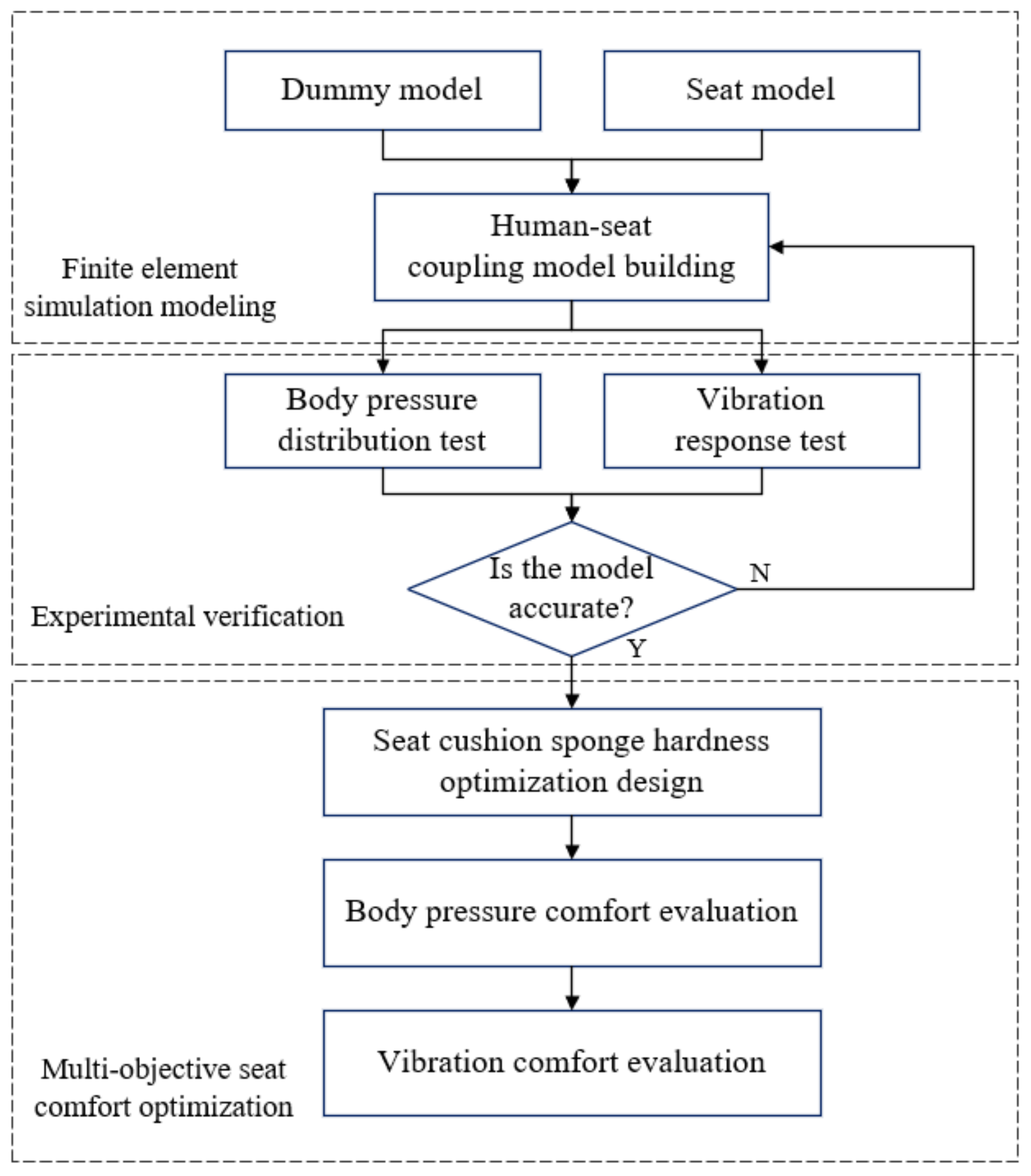
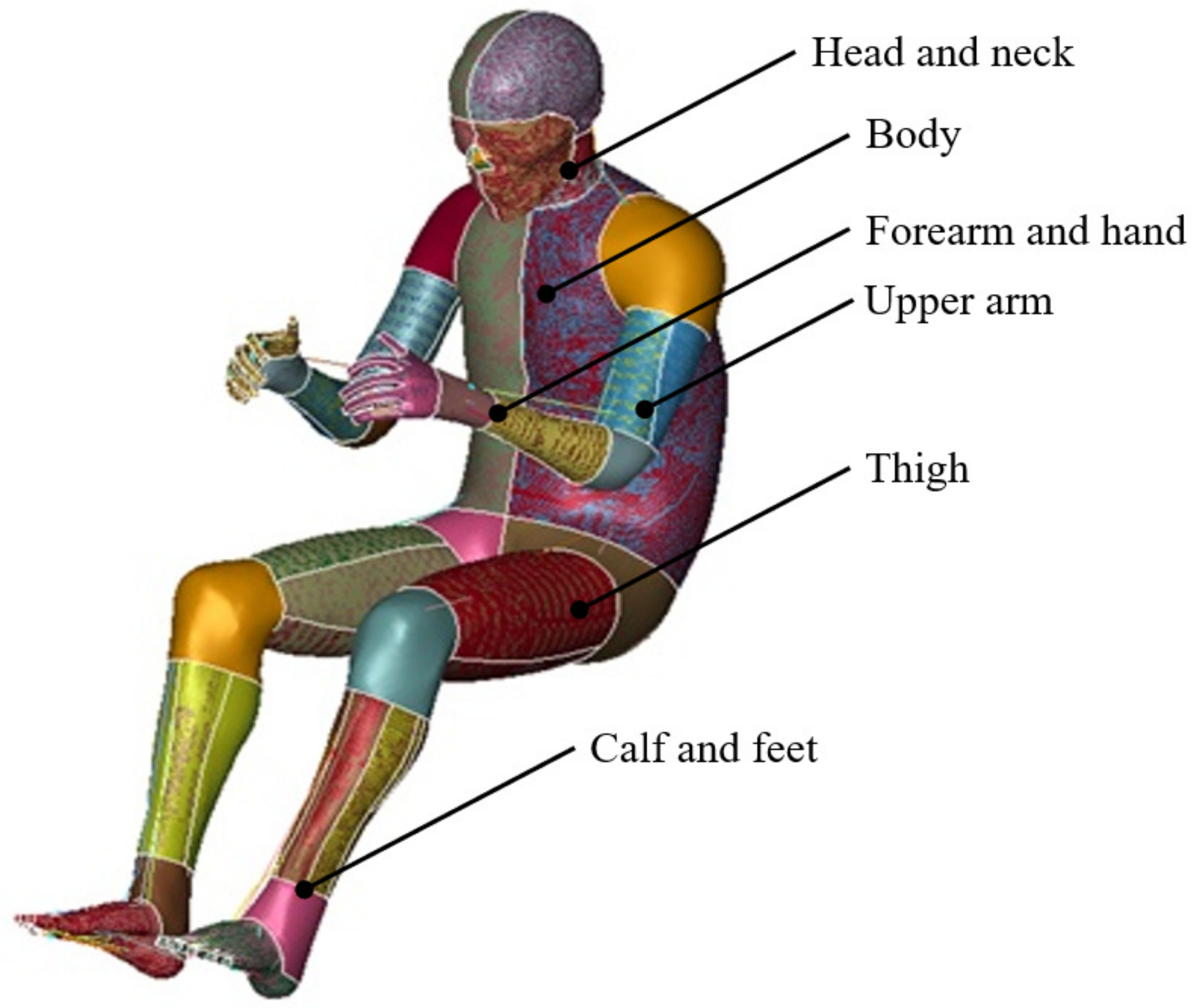
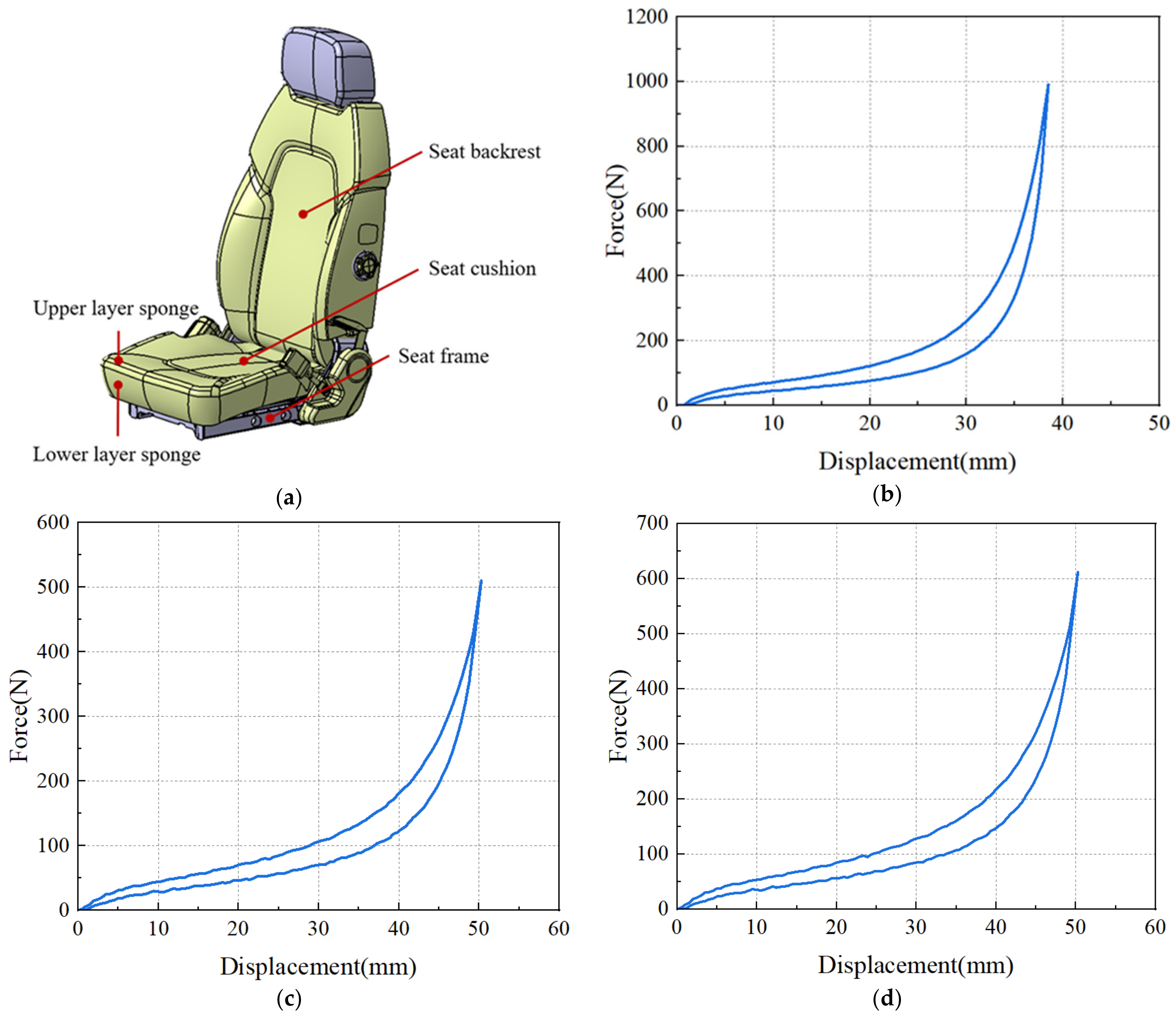

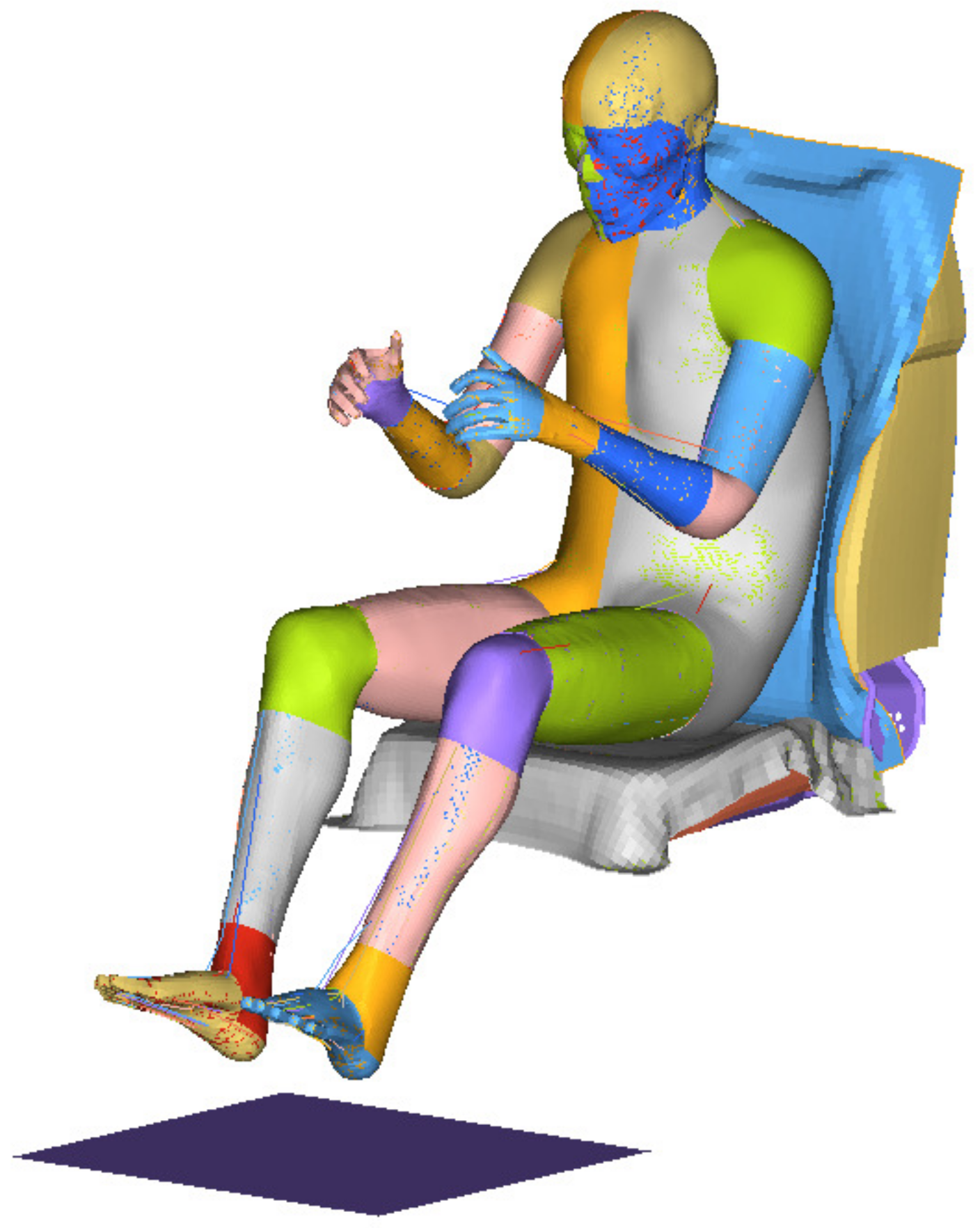



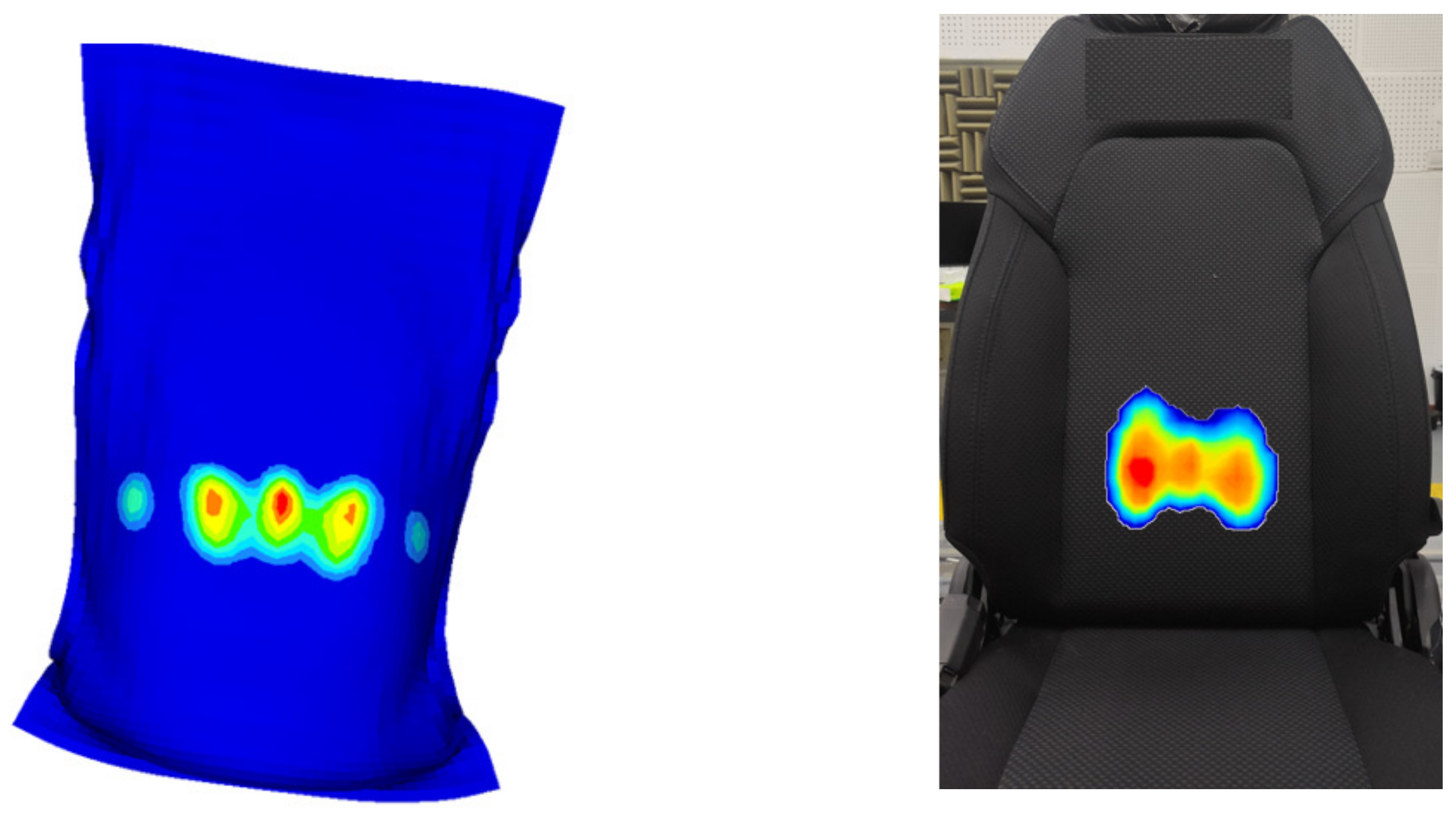
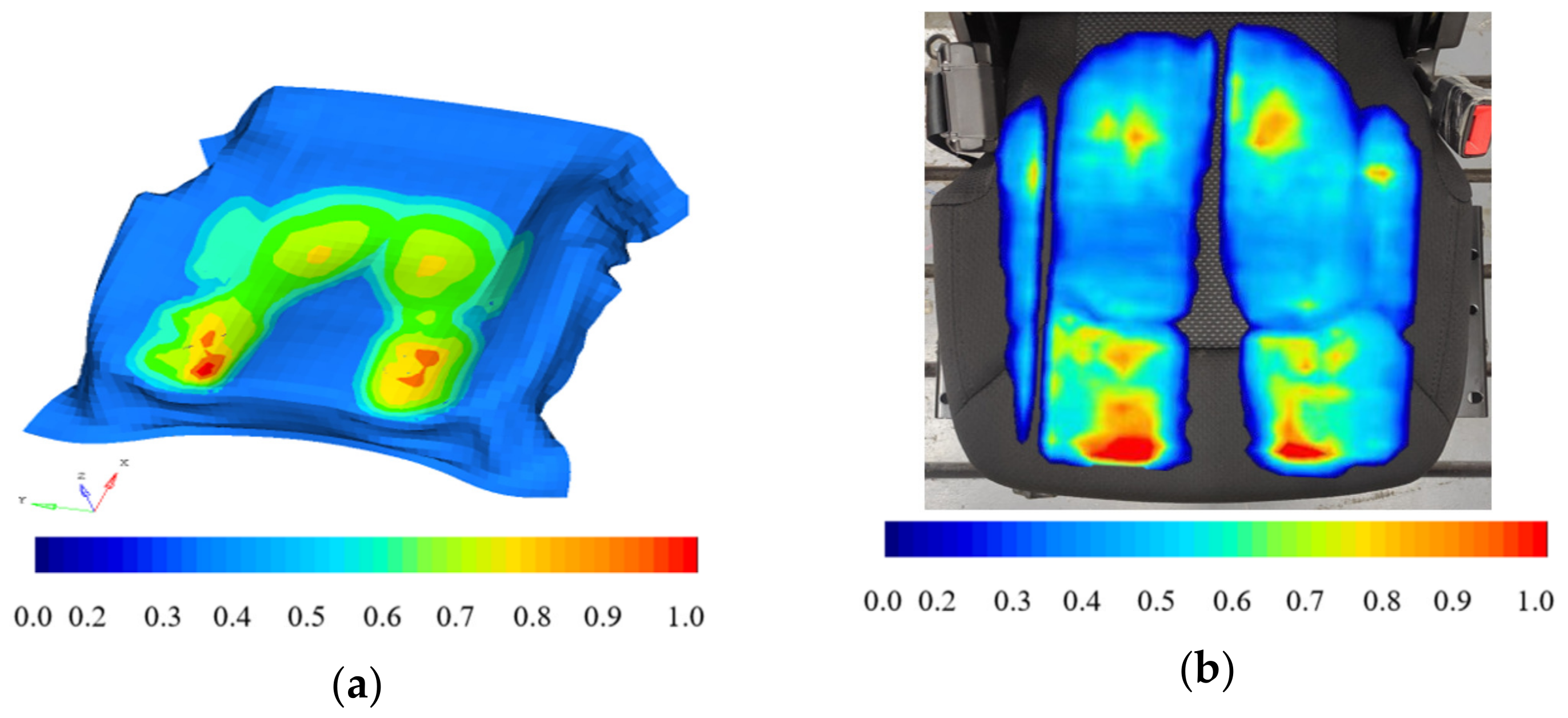
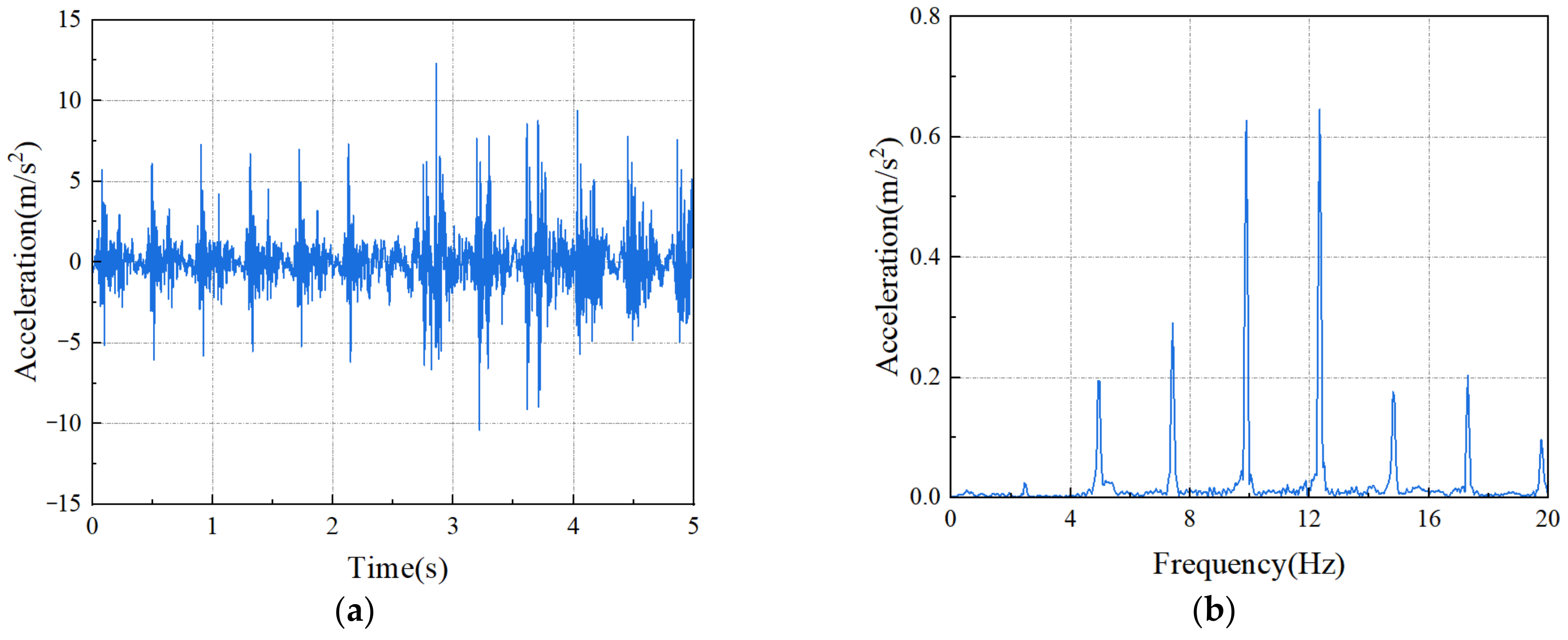
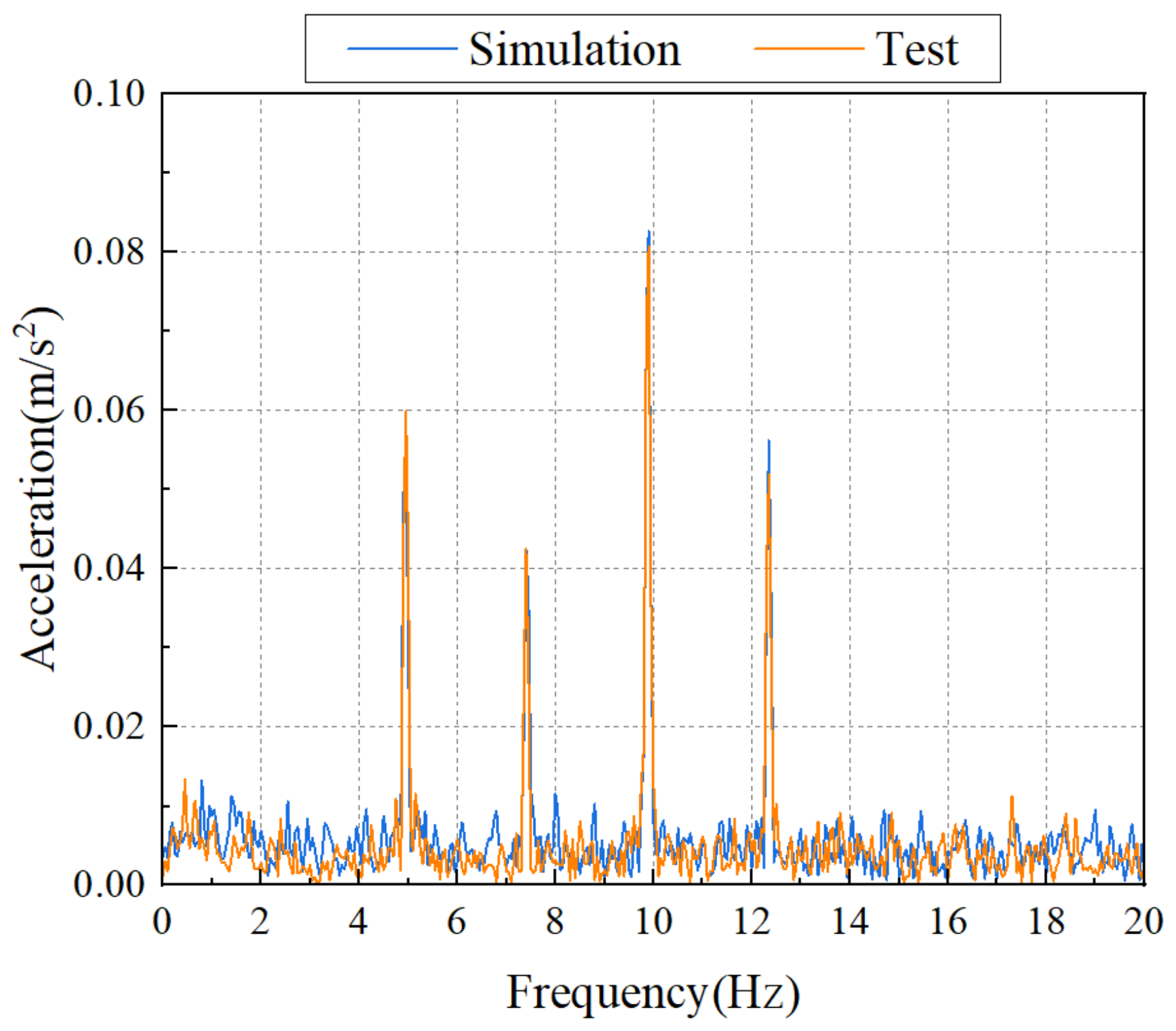

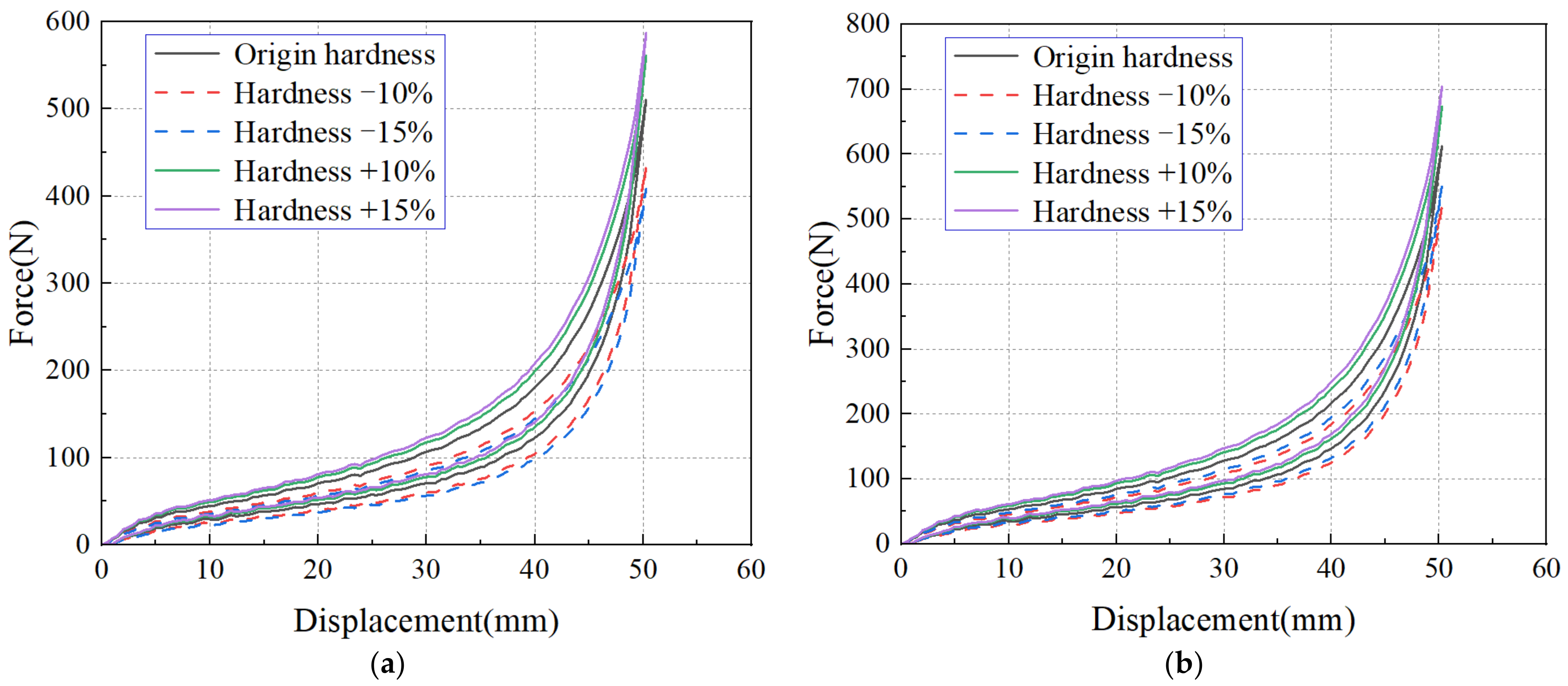
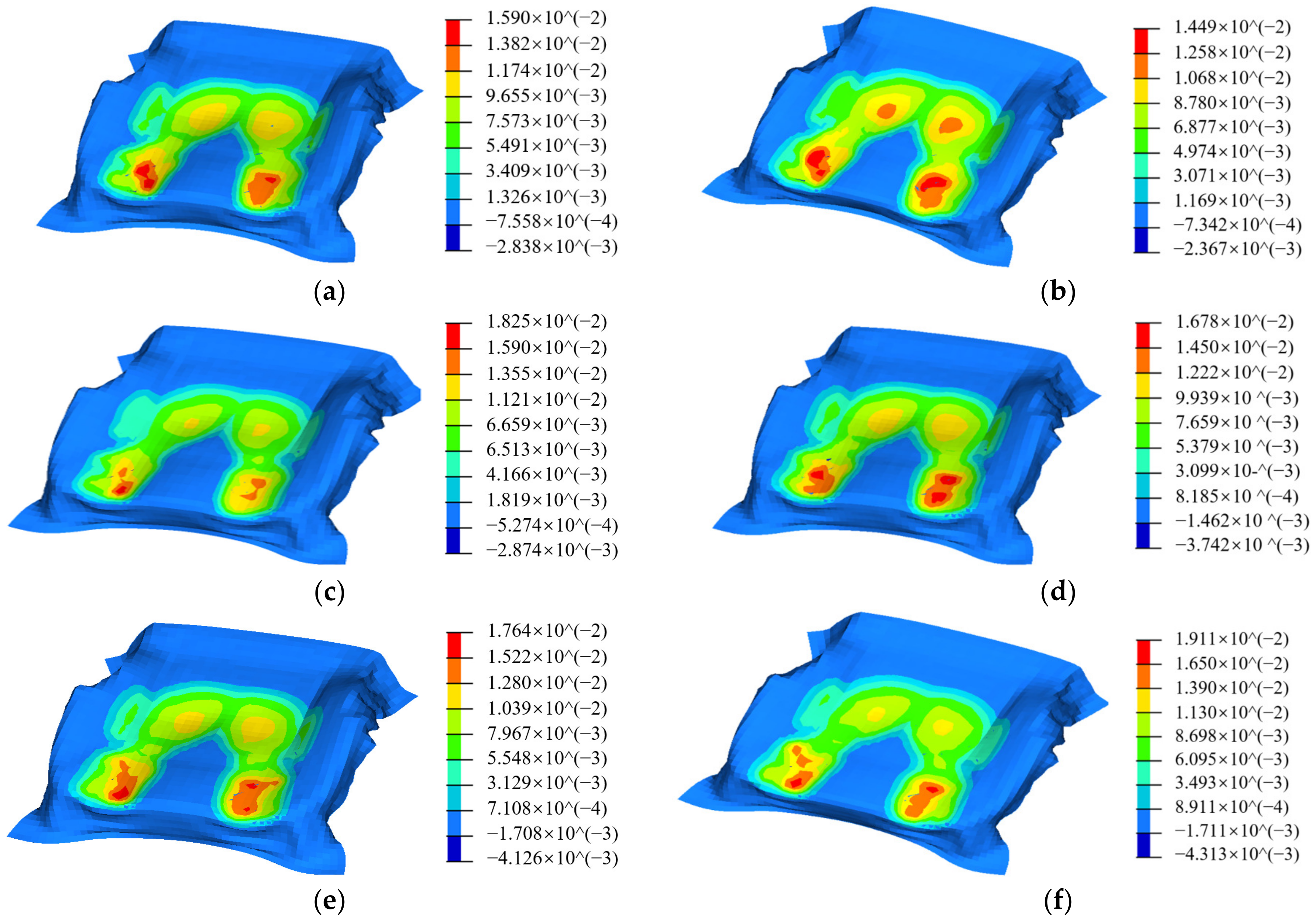

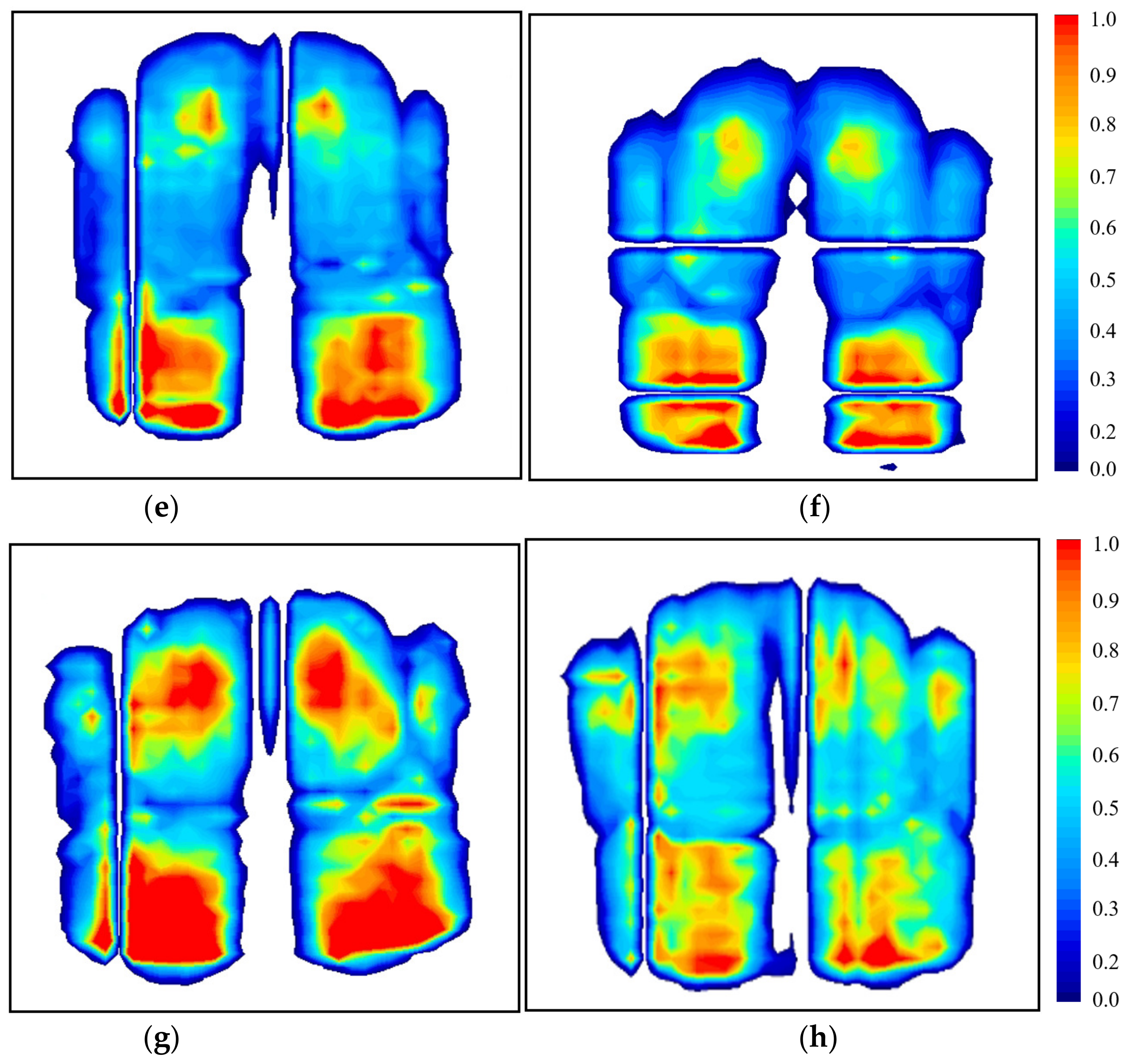

| Structure | m (kg) | Ixx (kg·m2) | Iyy (kg·m2) | Izz (kg·m2) | Ixy (kg·m2) | Iyz (kg·m2) | Ixz (kg·m2) |
|---|---|---|---|---|---|---|---|
| Cushion sponge (upper layer) | 1.134 | 0.021 | 0.022 | 0.041 | 0.00019 | 0.00006 | 0.001 |
| Cushion sponge (lower layer) | 1.551 | 0.027 | 0.031 | 0.056 | 0.00025 | 0.00008 | 0.0014 |
| Backrest sponge | 1.756 | 0.084 | 0.051 | 0.042 | 0.000006 | −0.000088 | −0.011 |
| Seat skeleton | 65.202 | 5.522 | 3.159 | 4.87 | −0.006 | 0.05 | −0.0047 |
| Human | Seat |
|---|---|
| The arms are bent in a forward position. | In the initial position, the guide is at the front of the seat slide design. |
| Adjust the backrest arch, the person’s back and backrest only in the waist. | Backrest inclination angle 12.5°. |
| Feet are stepped on the pedal posture, heel on the ground, calf and ground normal inclination of 20–25 degrees. | Cushion is 50 cm from the ground. |
| Frequency | Amplitude | ||||
|---|---|---|---|---|---|
| Simulation Value (Hz) | Test Value (Hz) | Accuracy (%) | Simulation Value (m/s2) | Test Value (m/s2) | Accuracy (%) |
| 4.95 | 5 | 99.0 | 0.0566 | 0.0599 | 94.4 |
| 7.4 | 7.5 | 98.7 | 0.0426 | 0.0424 | 99.5 |
| 9.9 | 10 | 99.0 | 0.0826 | 0.0807 | 97.7 |
| 12.35 | 12.5 | 98.8 | 0.0561 | 0.0519 | 92.5 |
| Sponge Stiffness (Upper Layer Sponge/Lower Layer Sponge) (N/mm2) | Ischium Peak Pressure (N/cm2) | Ischium Mean Pressure (N/cm2) | Thigh Peak Pressure (N/cm2) | Thigh Mean Pressure (N/cm2) |
|---|---|---|---|---|
| −15%/−15% | 1.25 | 0.78 | 1.51 | 0.75 |
| −10%/−10% | 1.24 | 0.88 | 1.26 | 0.71 |
| −10%/+15% | 1.27 | 1.01 | 1.59 | 0.89 |
| original | 1.28 | 1.03 | 1.61 | 0.92 |
| +15%/−10% | 1.12 | 0.64 | 1.67 | 1.13 |
| +15%/+10% | 1.13 | 0.72 | 1.64 | 1.10 |
| +15%/+15% | 1.16 | 0.74 | 1.56 | 1.08 |
| Subject | Body Information | |
|---|---|---|
| Height(cm) | Weight(kg) | |
| 1 | 165 | 60 |
| 2 | 171 | 70 |
| 3 | 175 | 77 |
| 4 | 182 | 86 |
| Subject | Ischium Peak Pressure (N/cm2) | Ischium Mean Pressure (N/cm2) | Thigh Peak Pressure (N/cm2) | Thigh Mean Pressure (N/cm2) | ||||
|---|---|---|---|---|---|---|---|---|
| Original | Improved | Original | Improved | Original | Improved | Original | Improved | |
| 1 | 1.43 | 1.27 | 0.86 | 0.53 | 1.49 | 1.46 | 0.62 | 0.56 |
| 2 | 1.48 | 1.16 | 0.94 | 0.50 | 1.55 | 1.48 | 0.54 | 0.44 |
| 3 | 1.28 | 1.26 | 1.03 | 0.76 | 1.61 | 1.36 | 0.92 | 0.81 |
| 4 | 1.82 | 1.58 | 1.26 | 0.84 | 1.85 | 1.52 | 1.45 | 0.92 |
| Subject | RMS (m/s2) | Vibration Isolation Rate (dB) | ||
|---|---|---|---|---|
| Original | Improved | Original | Improved | |
| 1 | 0.0489 | 0.0432 | 4.30 | 5.37 |
| 2 | 0.0685 | 0.0476 | 1.37 | 4.53 |
| 3 | 0.0551 | 0.0488 | 3.26 | 4.31 |
| 4 | 0.0673 | 0.0415 | 1.52 | 5.72 |
Disclaimer/Publisher’s Note: The statements, opinions and data contained in all publications are solely those of the individual author(s) and contributor(s) and not of MDPI and/or the editor(s). MDPI and/or the editor(s) disclaim responsibility for any injury to people or property resulting from any ideas, methods, instructions or products referred to in the content. |
© 2022 by the authors. Licensee MDPI, Basel, Switzerland. This article is an open access article distributed under the terms and conditions of the Creative Commons Attribution (CC BY) license (https://creativecommons.org/licenses/by/4.0/).
Share and Cite
Cheng, L.; Wen, H.; Ni, X.; Zhuang, C.; Zhang, W.; Huang, H. Optimization Study on the Comfort of Human-Seat Coupling System in the Cab of Construction Machinery. Machines 2023, 11, 30. https://doi.org/10.3390/machines11010030
Cheng L, Wen H, Ni X, Zhuang C, Zhang W, Huang H. Optimization Study on the Comfort of Human-Seat Coupling System in the Cab of Construction Machinery. Machines. 2023; 11(1):30. https://doi.org/10.3390/machines11010030
Chicago/Turabian StyleCheng, Lei, Hansheng Wen, Xiangyu Ni, Chao Zhuang, Wenjian Zhang, and Haibo Huang. 2023. "Optimization Study on the Comfort of Human-Seat Coupling System in the Cab of Construction Machinery" Machines 11, no. 1: 30. https://doi.org/10.3390/machines11010030





